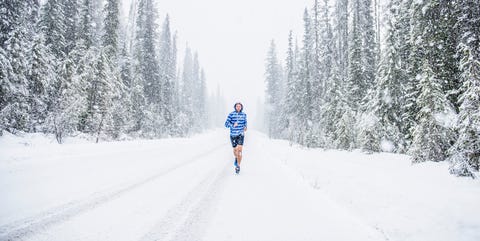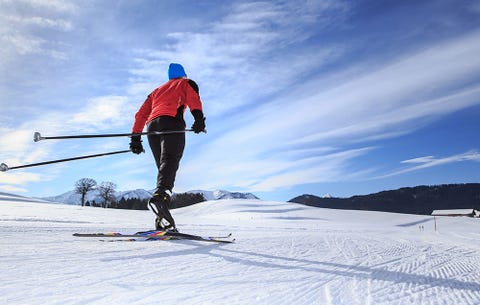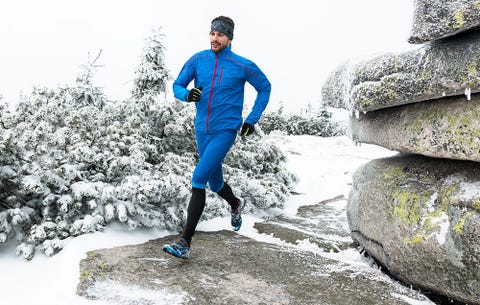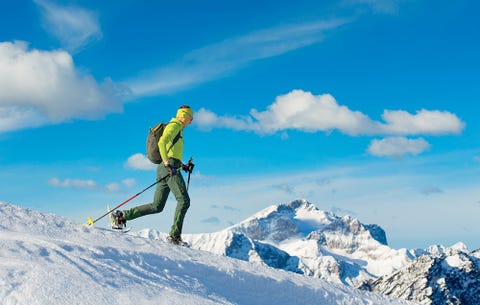
For most people, dropping temperatures and falling snow are a signal to start the winter hibernation. But if you’re looking to stay in shape all year ’round — and avoid developing a rotund, bear-like shape during the colder months — you should try to get outside to sweat in the snow.
Since the white stuff makes it tougher to do all your favorite summer activities, you’re going to have to find some new seasonally appropriate workouts. You wouldn’t walk outside in shorts in 20 degree weather, so it doesn’t make sense to try to exercise the same way you did when the thermostat was pushing higher temps. That takes (most) water-centric sports out of the running — now, the key is to find ways to make the most out of all that snow on the ground.
You’ll need some extra gear, wide open space, and a high-threshold for the frigid weather to try out these winter workouts. Once you get moving, though, you’ll start to burn calories and sweat as if you weren’t bundled up to stave off the chill. Try these 3 workouts to beat cabin fever and make even your beach body jealous.
Shutterstock
Don’t let the skinny skis or its image as an elite Olympic sport scare you away. You can learn to ski cross-country in an afternoon.
Robert Peay, 45, of the nutrition bar company Probar, recalled feeling like a newborn giraffe the first time he stepped out on slippery, packed snow wearing a pair of Nordic skis.
“It’s the most physically demanding activity I’ve ever done,” he says. “It works your legs and arms. Your heart is pumping.”
In summer, Peay joins his friends for mountain bike rides around his hometown of Park City, Utah.
But come winter, his buddies ditch him and descend into the gym, while Peay simply switches his bike for Nordic skis and scores an even bigger cardio benefit.
Peay does a form of Nordic skiing called skate skiing, the kind you see in the Olympics. It makes use of shorter skis that allow the skier to push off to the side like ice skaters do.
Poles are used for balance and propulsion. “Unlike on a bike, where only certain body parts are getting a workout, Nordic skiers need to use their whole body to propel forward,” Peay says.
That can deliver a burn of 735 calories an hour. You’ll spend less time looking like a baby giraffe if you practice these drills.
Balance Your Power
With your skis on, stand flat and shift your weight from side to side, your body going over each ski. Do this for two minutes.
Then hop from side to side for two minutes. Do those drills often.
“The concept of shifting your weight from ski to ski is critical in skating,” says U.S. Ski Team cross-country coach Chris Grover.
The drills teach you how to balance on your skis, fully shift your weight over each ski, and distribute your weight evenly. That can help prevent problems like catching your inner edge and not having enough glide.
Build Your Stamina
Once you’re ready, ski: Shift your weight directly over your right ski, dig its edge into the snow, and push off, your left ski gliding flat atop the snow. Push off with your poles too.
As you begin to move forward, transfer your weight and repeat the motion with your left ski, your right ski on top of the snow. Keep going, pushing with one leg and gliding with the other.
Dig your poles in after every other leg thrust. Aim to glide for a total of about two minutes on each leg.
Shutterstock
Sure it’s cold, but winter can be the best time to hone your form and extend your endurance.
When Nathan Ansbaugh, 32, left Oregon for the long, stressful hours of an emergency-medicine residency in Minneapolis, he dedicated himself to hitting the trails no matter what the weather.
That might have seemed crazy considering Minnesota’s long, frigid winters.
But Ansbaugh began exploring the snow-packed trails around the Twin Cities and developed a workout routine that complemented his new life as a resident, his desire for athletic intensity, and the reality of really bad weather.
The result? Introspective time that pays off when summer arrives.
“In winter I don’t focus on times and distances or pace or intervals,” he says. “I run three or four times a week and think more about form. Best of all, I can take time to explore,” says Ansbaugh. “Your footprints are always there in the snow to lead you back to the car.”
To run snow-packed trails, you need more balance and improved fundamentals.
Fine-Tune Your Form
Winter trail running requires a careful foot strike to avoid falls.
Concentrate on landing on the balls of your feet to safeguard yourself on slippery winter trails.
“I slip if I’m heel striking,” says Ansbaugh.
A shorter stride offers stability and distributes the impact more evenly.
When it comes to your workouts, change them up. “If you run three days a week, vary your length and speed each day,” says Alex Viada, C.S.C.S., co-owner of Complete Human Performance, a training facility in Durham, North Carolina.
He suggests doing a day of intervals (10 fast quarter-mile efforts, for example), a day of tempo work (run for 30 minutes at a pace that’s too fast for you to carry on a conversation), and a day of slower, longer-distance running.
Upgrade Your Footwear
If you plan to challenge yourself on steep, icy runs, invest in winter trail running shoes with built-in traction spikes or specialized soles.
But for most packed snow and even untracked snow, warm-season trail runners work just fine.
In fact, you may want to stay away from shoes with waterproof or breathable membranes, because any water that gets inside can’t escape. That makes your feet soggy and causes blisters.
Double Your Warmup
To avoid injury on cold winter days, a proper warmup is critical.
Ansbaugh takes a lap or two in a jacket and then sheds it after he’s primed.
He braves the cold with a system of layers: tights, pants (fleece-lined for the truly frigid days), and a wicking long-sleeved top.
For milder temperatures, he brings a weather-resistant soft shell. He also wears thick, wind-resistant gloves and keeps a balaclava on hand so his nose won’t freeze.
Getty Images
Consider this a wilder, more adventurous version of hiking that enables you to truly take the path less traveled.
Way up in the frozen New England woods, winter does nothing to slow down Al Sochard, 56, facilities director at Camp Newfound-Owatonna in Harrison, Maine.
“We have five months of winter up here, so you either sit inside or find a way to get out,” says Sochard, who in summer is a dedicated ultrarunner and hiker. His winter workout: snowshoeing.
The sport opens up an entire world of winter wilderness, putting you in the middle of a Robert Frost poem, says Sochard. The cold and snow won’t slow down your adventures.
Plus, according to Sochard, snowshoeing is easy to learn. “It’s great for people who are uncoordinated,” he says. “Unlike with skiing, there isn’t a learning curve and you don’t have to worry about crashing into a tree.”
But that doesn’t mean snowshoeing is for the uninspired: Sochard summited all 48 of the 4,000-plus-foot New Hampshire peaks in a single winter. He also used snowshoes when he climbed Denali, the highest peak in North America.
“Winter is my favorite time of year. I won’t stop or slow down,” says Sochard. “It’s a way to get exercise, sure.
But it’s also a way to explore. I can look out and see someplace I want to go, and I go.”
Learn The Basics
Generally, snowshoeing is no different than walking. In deeper snow and when you’re moving uphill or downhill, you want to take heavier, more confident steps.
But be sure to test your footing first so the snow doesn’t collapse under your weight, even with the buoyancy the shoes provide. Bring a small backpack with plenty of water.
Shop Smart
The tricky part is choosing the right equipment.
Will you be using your snowshoes to hike? You may not want poles if you’re running at full speed on packed trails or logging roads, but a pair of poles can be your best friend when you’re trudging up steep hills in the backcountry.
Poles can also add an element of upper-body conditioning to your workout. Trekking poles are best; just change out the standard baskets with larger snow baskets.
Make sure you select snowshoes that can support your weight. The whole premise of snowshoeing is to distribute your mass so you don’t sink deeply into the snow.
If you plan to tromp on mostly level ground, look for a pair of flat-terrain snowshoes, which are easy to get into and out of; their traction systems aren’t as aggressive as those on other types.
If you’re hiking hills or steep trails, go with rolling- or mountain-terrain shoes, which have rugged bindings and sharp metal teeth for clawing into steep, icy hills.
Head Out And Explore
Because snowshoeing is more about enjoying the calm serenity of the woods than jacking up your heart rate, you’ll want to dress heavier.
Sochard likes to wear a light, wicking long-sleeved shirt under a non-insulated, weatherproof shell. Carry a headlamp if you plan to go out at night or are headed deep into the exposed backcountry.
Take avalanche safety classes and bring the right equipment (shovel, transceiver, probe) before you venture into areas where snowslides are common. Unwitting snowshoers have been killed in avalanches, even on trails.
Source: Read Full Article


